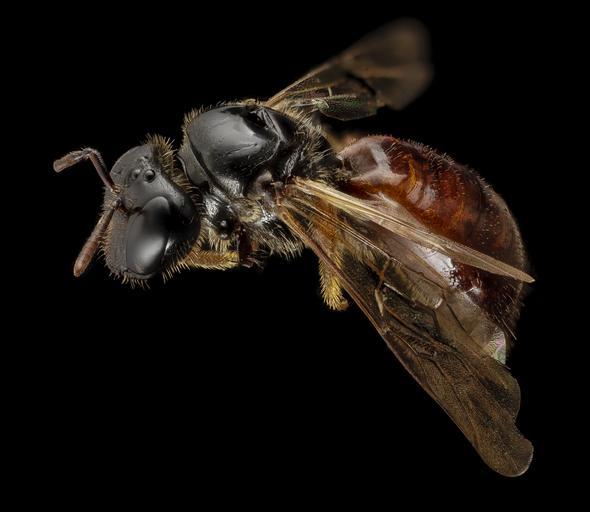MAKE A MEME
View Large Image

| View Original: | Exoneura_species,_f,_australia,_back_2014-11-01-21.46.18_ZS_PMax.jpg (3252x2821) | |||
| Download: | Original | Medium | Small | Thumb |
| Courtesy of: | www.flickr.com | More Like This | ||
| Keywords: bee bees insect insects hymenoptera taxonomy:genus=exoneura biml usgsbiml droege apoidea apidae макросъемка makro マクロ природа natur 自然 الطبيعة 大自然 naturaleza natura насекомое insekt 自然الحشرة 昆蟲 insectos australia down under downunder oz black background animal macro Exoneura species, Two-tone Reed Bee, specimen collected in Australia Long: Reed Bees are found only on the continent of Australia and it is likely that most of the 41 species nest in the pithy centers of plant stems, similar to the Small Carpenter Bees (Ceratina). These bees have a unique method of childcare: rather than constructing individual cells for their young, they dispense with internal walls and make a crèche. They excavate the pith in the stem, add pollen and nectar, and then lay eggs over time. Thus, within a nest there can be bee juveniles at all stages of development, from egg to adult sometimes several adults. These groups of females can all be reproductive but often just the dominant female produces eggs. This dominant female can produce pheromones that keep the ovaries of subdominant females from developing. The home life of these bees is complex but flexible such that working positions within the colony and reproduction can change with the seasons and availability of pollen and nectar. Perhaps because all the larvae are together within the nest burrow rather than in their own individual little rooms, their morphology is more complex and variable than is the case for larvae of other bees. Most bee larvae are simple grubs lacking legs and mostly bald. Reed bee infants often have fleshy lobes and interesting hair patterns on their bodies, some even looking as if they have a Beatle’s moptop cut. ~~~~~~~~~~{{{{{{0}}}}}}~~~~~~~~~~ All photographs are public domain, feel free to download and use as you wish. Photography Information: Canon Mark II 5D, Zerene Stacker, Stackshot Sled, 65mm Canon MP-E 1-5X macro lens, Twin Macro Flash in Styrofoam Cooler, F5.0, ISO 100, Shutter Speed 200 Further in Summer than the Birds Pathetic from the Grass A minor Nation celebrates Its unobtrusive Mass. No Ordinance be seen So gradual the Grace A pensive Custom it becomes Enlarging Loneliness. Antiquest felt at Noon When August burning low Arise this spectral Canticle Repose to typify Remit as yet no Grace No Furrow on the Glow Yet a Druidic Difference Enhances Nature now -- Emily Dickinson Want some Useful Links to the Techniques We Use? Well now here you go Citizen: Basic USGSBIML set up: www.youtube.com/watch?v=S-_yvIsucOY USGSBIML Photoshopping Technique: Note that we now have added using the burn tool at 50% opacity set to shadows to clean up the halos that bleed into the black background from "hot" color sections of the picture. www.youtube.com/watch?v=Bdmx_8zqvN4 PDF of Basic USGSBIML Photography Set Up: ftp://ftpext.usgs.gov/pub/er/md/laurel/Droege/How%20to%20Take%20MacroPhotographs%20of%20Insects%20BIML%20Lab2.pdf Google Hangout Demonstration of Techniques: plus.google.com/events/c5569losvskrv2nu606ltof8odo or www.youtube.com/watch?v=4c15neFttoU Excellent Technical Form on Stacking: www.photomacrography.net/ Contact information: Sam Droege sdroege@usgs.gov 301 497 5840 Exoneura species, Two-tone Reed Bee, specimen collected in Australia Long: Reed Bees are found only on the continent of Australia and it is likely that most of the 41 species nest in the pithy centers of plant stems, similar to the Small Carpenter Bees (Ceratina). These bees have a unique method of childcare: rather than constructing individual cells for their young, they dispense with internal walls and make a crèche. They excavate the pith in the stem, add pollen and nectar, and then lay eggs over time. Thus, within a nest there can be bee juveniles at all stages of development, from egg to adult sometimes several adults. These groups of females can all be reproductive but often just the dominant female produces eggs. This dominant female can produce pheromones that keep the ovaries of subdominant females from developing. The home life of these bees is complex but flexible such that working positions within the colony and reproduction can change with the seasons and availability of pollen and nectar. Perhaps because all the larvae are together within the nest burrow rather than in their own individual little rooms, their morphology is more complex and variable than is the case for larvae of other bees. Most bee larvae are simple grubs lacking legs and mostly bald. Reed bee infants often have fleshy lobes and interesting hair patterns on their bodies, some even looking as if they have a Beatle’s moptop cut. ~~~~~~~~~~{{{{{{0}}}}}}~~~~~~~~~~ All photographs are public domain, feel free to download and use as you wish. Photography Information: Canon Mark II 5D, Zerene Stacker, Stackshot Sled, 65mm Canon MP-E 1-5X macro lens, Twin Macro Flash in Styrofoam Cooler, F5.0, ISO 100, Shutter Speed 200 Further in Summer than the Birds Pathetic from the Grass A minor Nation celebrates Its unobtrusive Mass. No Ordinance be seen So gradual the Grace A pensive Custom it becomes Enlarging Loneliness. Antiquest felt at Noon When August burning low Arise this spectral Canticle Repose to typify Remit as yet no Grace No Furrow on the Glow Yet a Druidic Difference Enhances Nature now -- Emily Dickinson Want some Useful Links to the Techniques We Use? Well now here you go Citizen: Basic USGSBIML set up: www.youtube.com/watch?v=S-_yvIsucOY USGSBIML Photoshopping Technique: Note that we now have added using the burn tool at 50% opacity set to shadows to clean up the halos that bleed into the black background from "hot" color sections of the picture. www.youtube.com/watch?v=Bdmx_8zqvN4 PDF of Basic USGSBIML Photography Set Up: ftp://ftpext.usgs.gov/pub/er/md/laurel/Droege/How%20to%20Take%20MacroPhotographs%20of%20Insects%20BIML%20Lab2.pdf Google Hangout Demonstration of Techniques: plus.google.com/events/c5569losvskrv2nu606ltof8odo or www.youtube.com/watch?v=4c15neFttoU Excellent Technical Form on Stacking: www.photomacrography.net/ Contact information: Sam Droege sdroege@usgs.gov 301 497 5840 | ||||